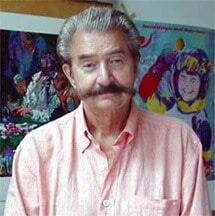He attended a Roman Catholic primary school and was constantly showing off his artistic skills. As a high school student, he created posters for school dances and athletic events. In 1942, Neiman quit high school and enlisted in the U.S. Army. While serving as a cook he painted murals in military kitchens and dining halls. He also painted stage sets for Red Cross shows under the Army’s Special Services division.
Early in his career, Neiman began teaching at the School of the Art Institute of Chicago, a post he kept for ten years. He was awarded first prize in the Twin City show for an oil painting, “Idle Boats,” in 1953. He had his first solo shows in galleries in Chicago and Lincoln, Illinois that same year. In 1957, one of his paintings was included in the “American 25th Biennial Exhibition.” In 1961, he won a gold medal at the Salon d’Art Moderne, in Paris.
In the early ‘50s, Neiman was freelancing for a Chicago department store and made the acquaintance of Hugh Hefner, a copywriter there. By the next year, Hefner was publishing his first issue of “Playboy.” For 15 years beginning in 1958, Neiman was a contributing artist and writer for “Man at His Leisure” in Playboy magazine.
Through the years he had donated scores of his artwork to charitable organizations, and in 1995, he gave the School of the Arts at Columbia University a gift of $6 million to create the LeRoy Neiman Center for Print Studies.
Style and Influences
The “spirit” of Leonardo and Rubens, the “space” of Tintoretto, and the “feel” of Fragonard all influenced LeRoy Neiman’s early works. He was greatly influenced by the abstract expressionists, especially Jackson Pollack, who was also one of the first artists to experiment with serigraphs. Later, as Neiman became one of the foremost colorists, inspiration from the Impressionists, Fauvres, and Romantic Realists would find its way into his work.
The majority of Neiman’s body of work deals with sports: golf, basketball, boxing, billiards, hockey, football, baseball, gymnastics, swimming, cycling, bullfights, boxing, auto racing, polo, ballet, sailing (Americas Cup), chess (Fisher and Spassky Championship, 1972) and The Olympic Games (1972 Munich, 1976 Montreal, 1980 Lake Placid, 1984 Sarajevo, and Los Angeles).
Neiman’s use of vivid tones evokes a phenomenon of change and dynamism. Up close, his paintings appear abstract. From a distance, they become articulated and more defined, presenting recognizable imagery. He accomplished this with fast moving strokes, giving the impression of action. His use of vivid color electrifies his paintings and serigraphs.
By his own account, Neiman used to say he was a workaholic, taking no vacations and having no hobbies. He lived with his wife in a double high studio in the Hotel des Artistes, a landmark in New York City.
LeRoy Neiman: Accomplishments
LeRoy Neiman: Exhibitions
- LeRoy Neiman has had solo exhibitions at the Minnesota Museum of Art, St. Paul; University of Texas, El Paso; Abbey Theatre, Dublin, Ireland; Museo de Bellas Artes, Caracas, Venezuela; and the New State Tretyakov Museum in Moscow.
- In 1981, LeRoy Neiman and Andy Warhol had a two-man exhibition at the Los Angeles Institute of Contemporary Art.
- LeRoy Neiman work is in the permanent collection of the Hermitage Museum in St. Petersburg, Russia.




